 |
Car preparation for track days |
by Peter Scott
Firstly don't wait until the car is perfect - get out there! Plenty of time to get those special tyres or whatever later - just get out there and have fun.
There are two types of trackdays - the flat rate $70 non-licensed come and try day (popular at Mallala South Australia) and the CAMS (Confederation of Australian Motorsport) approved and licensed Sprint days.
Insurance - there is none! Check your life insurance - does it cover you for dangerous activities? Check ! I had to change my insurer because of this issue. There is no insurance for your car if you stack it or someone rams you. BUT this isn't racing - it's qualifying - people are spread out on purpose - everyone wants space to do the best lap they can. I have sustained more damage to my car in shopping car parks then I have seen to any car at a track day. Well except for that one Wally in his mates EVO 6 - but some people just go too fast too early. So there is risk. But I have been several times now - and I feel safer on the track than on the road with the plebs.

This photo is at Mallala. For a CAMS event max allowed is 8 cars. The first car in front of me is that red 968 Porsche way over there - miles away - same distance behind me is another Porsche. No-one is diving in under brakes! All the runoff areas are smooth grass - nothing to flip you over if you stuff up - lots of runoff areas. No blind corners - I mean look at it! - No surprises - the ultimate place for a rip-snorting drive in your car. Phillip Island is the same thing with hills. Don't drive fast on the road - save it for the track. If you are going to modify your car to make it handle and go faster - take it to the track and enjoy it.
Will my car blow up? - no! I have worn out tyres and brake pads - but the car is still just fine. The car deserves a good thorough service before a trackday - fluids, pads etc - but the car will be just fine. Look after it and maintain it and it will be ok.
Will I crash my car? Doubt it. You are driving harder - but the surface is better, no blind corners, no hats, no one coming the other way, no one falling asleep or reversing and no trees by side of road. Don't over drive, take the new drivers training available and build it up gradually. Crashes are rare at sprint days. Crashes with other cars even more so. It's a risk alright - but it's one that I don't think is very big.
Helmet - you'll need one in good condition. My old bike helmet was rejected - too old (10 year max) and scratched. So I went and bought this one for $220, nice and new, new visor you can actually see through - it's not bad at all. It's at the cheap end of the range. To replace my Mick Doohan Bleary Eyeball Arai Helmet to same spec is up near $1000 - stuff that! I went for full face because I still imagine getting back into bikes. But for car only a lightweight open face helmet from $150 will be fine. CAMS put a 2003 sticker on it at the track. I squeeze my metal framed sunglasses on as well.
Gloves - recommended but not a requirement. I wipe my hands a lot when driving hard - the leather wheel gets slippery - so I got some gloves. I spent the extra on the fancy FIA Nomex specials ($110) - feel real nice. Cheaper karting gloves around $40.
Non flammable clothing neck arms and legs. Jeans and a cotton jumper or long sleeved shirt. Don't wear your polyester Elvis suit - I know it looks cool and everything, but if it catches fire it will stick to your skin nasty like - remember that bad guy in Panic Room? I wear jeans, long sleeved cotton work shirt if it's hot, windcheater if it's cool, and black leather shoes. You can get fancy shoes - but I haven't felt the need. There is one hot driver at Phillip Island who has metallic blue shiny plastic driving shoes - looks very serious!
Blue triangle for battery location. - Yes for Mallala - should be for Phillip Island too - but you can get away without it.

Sticker kits - not needed. You only need blue triangle by itself. But getting stickered up is half the fun. I've been lucky - I've been able to select 32 at Phillip Island and Mallala (UZZ32 - get it?). Sometimes a number is assigned to you. At Phillip Island you can just take what they give you - they will provide a yellow number for the window regardless. At Mallala you have to provide your own number. If you don't nominate a number there is some of that white shoe polish stuff - you can put that on the window. You need a number to get timed.
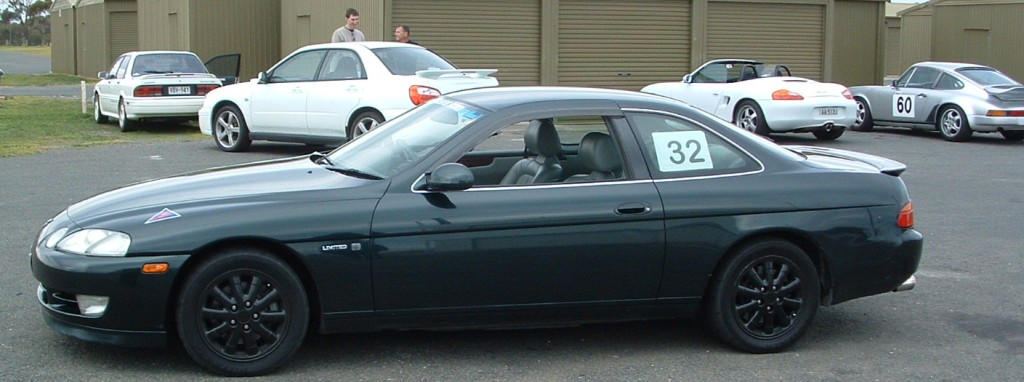
At Mallala you need blue triangle and bring your own number - I printed it out at home. No-one had 32 last time I was there so I took the chance and brought it for the day.
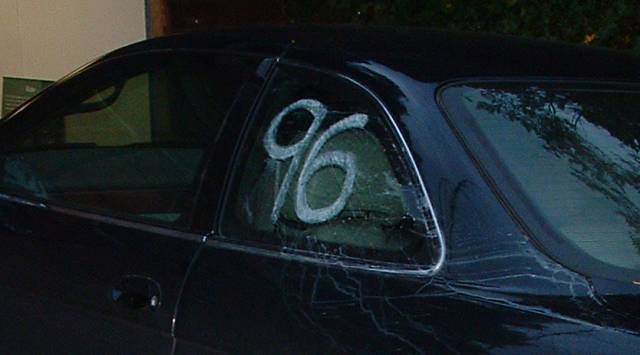
Last time I just took any number - I got 96 and it was done in white scuff stuff - went all over the car in the rain.
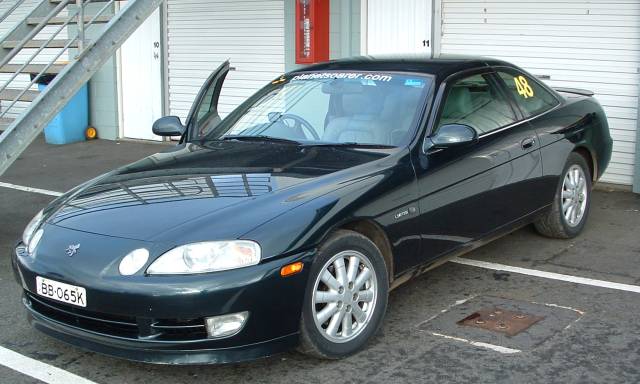
At Phillip Island I got a random number - 48 in this case - provided on the day. No blue triangle and it was ok too.

First time at PI I got sticker up - bags of fun. Even put the TOW stickers on.
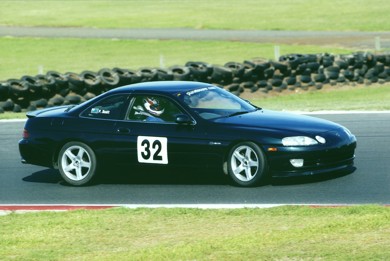
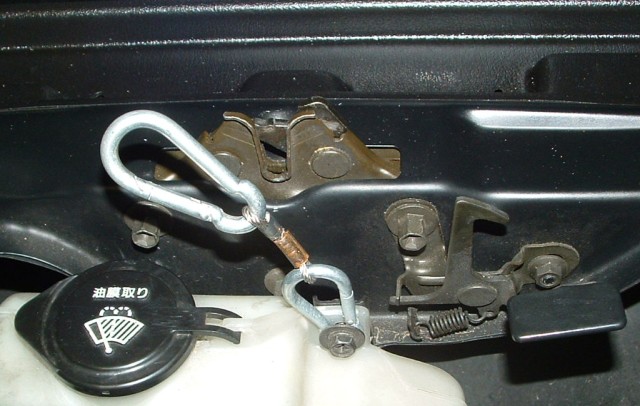
Bonnet restraint is needed for sure. It's easy. Go down to hardware store - get two of these D shackles, then go get some chain - 4 or 5 links ought to do it. Connect it up like shown and your done. Don't have to do the fancy wire crimp like Rob Hayden did for me. The length of the restraint? - make it long enough so you can undo it - no-one measures it or anything. David Ross forgot his once and used a work tie - leather belts, old seat belts etc - but I think the above is cheap and easy - stays there the whole time so you don't forget it either.

1 kg fire extinguisher. Motorsport ones have metal handles, metal brackets with stainless steel straps and are supported top, bottom and middle. Has to be bolted or screwed to metal within reach of driver. Mine bolts to metal bracket under backseat. Quickest method is to remove back seat and use two self tapping screws into metal brackets - don't need to go through body of car! Rob has neat metal straps that bolt to front seat bolts - extinguisher is under knees on the floor. I leave the extinguisher there all the time now. Took it out once taking some friends out for dinner. Dry powder extinguisher is used by criminals to remove fingerprints from stolen cars. When insurance assessors see white powder in cars they write it off. The white powder gets in everything and causes problems with electrical wiring for ever. It is bad stuff - good for putting out fires - but bad stuff. Hopefully you'll never need it. More likely you'll need it for others on the side of the road etc or in the shopping car park.
CAMS licence - you can apply on the day. All you write on the form is the name and address of your doctor - next of kin and your done. Cost $91 for a whole year. Credit card is fine. You get the logbook and CAMS magazine. Some of my favourite people have a CAMS licence and no drivers licence! CAMS licence gives you sex appeal. Name drop the CAMS licence and stretch the truth saying you are a professional motorsport driver etc. Inside log book is your licence for a year. And spots to jot down highlights of your trackday career. I sticky tape in the back my membership card for PIARC and PCSA.
You'll will need to join the club that is running the event. You can join most of the sports car clubs as an associate. I am an associate member of the Porsche Club for example - $30 a year.
Tyres - pump up your street tyres to +45 psi - I know this sounds like a lot of pressure, but street tyres have softer sidewalls - they need the pressure to survive. Fancy motorsport tyres are nice - but they cost extra. First time out street tyres are ok. There will be lots of time to experiment with fancy tyres. You will need the wear bars on the tyres to be indicating good tread depth. Mallala and Porsche club are fussy with tyres and tread depth - Phillip Island not so much. Street tyres get too hot after three laps. If the car starts sliding around too much slow down, get off track and cool tyres down. If the tyres overheat you'll destroy them. It is normal for rubber to start to balling up and sliding across the surface - but take it easy on street tyres - don't abuse them. Motorsport tyres last 3000 km on the street, Street tyres last upwards of 25 000 km - they aren't designed for track days. They will be ok - but just keep in mind they don't like getting too hot.
Brakes - you'll need at least half pad thickness left. This isn't street driving, your pads will wear much quicker on the track. So check them - if they are getting low put new ones in. You'll want plenty of meat on the pads. You'll be ok with the standard brakes and pads. Upgrading them later is half the fun. My UZZ32 is the only V8 to come standard with the larger Twin Turbo brakes front and rear. But I still upgraded the lines to stainless steel braided, new front slotted rotors and EBC greenstuff pads. Good enough for the street. Good enough for Phillip Island. Marginal at Mallala - survive short sprint sessions - but long practice sessions - nope. Give the brakes a chance to cool down. Drive for a bit - don't let hot callipers or handbrakes sit - the disks won't cool evenly.
Petrol - I use a full tank of fuel for the day - so fill up with the good stuff on the way there - fuel economy is terrible on the track. I'll use 5 litres (over a gallon) in one 10 minute session. 15 km and 5 litres - about 35 litres per 100km or 7 mpg - it's a lot of fuel!
Steering, wheel bearings, bushes, brake lights, battery tie down - all are checked on the day - Not over a pit or anything - but a jiggle of the steering wheel and a push and shove on the front wheels.
Oil - change it before, not after a track day. Oil filter too. Check air filter. I use new Toyota filters and full syn oil for track days - regular oil is ok for the V8. I don't recommend overfilling the oil level for a trackday.
Power steering fluid. Check level, flush if possible. It's going to get a good workout.
Transmission fluid. Check - when was last service? I have installed a trans cooler - good value at $120 installed.
Coolant. Check level. When was last change? Check top tank. Many 1991 and 1992 Soarers are cracking top tanks last year, this year or next year. Probably best to change it before it let's go.
Seat belts. Have seen a young kid go home in tears - his seat belts were a bit worn on the edge. I used the Stan Johnson trick for the Soarer belt. Push seat right back. Grab hold of belt and yank fast so that it jams. Then move seat forward until it gets real tight - it will stay jammed and help to hold you in nice and tight without sliding everywhere.
Give the car a wash and be prepared to answer questions - people are curious - not too many Soarers on the track. I leave bonnet open and windows down - people like to have a sticky beak at all the bits.

You will have to remove everything form the car - no spare, no jack, no coins, no CD's no street directory, no camera no nothing. Anything loose comes out of the car. We stack it up in a pile and leave it there. I have no carpet here because getting three race wheels in is a squeeze - easier with no air in them - but then you have to pump them up when you get to track.
CAMS - $91 a year
club membership - $40 a year
Helmet - $150
sticker - $5
sprint fee - $100 a day
extinguisher - $40
First lap on a trackday take it easy!!!!! Calm down!!!! Plenty of time to build speed. Listen to car. Feel the track and the car. Speed will come naturally and it won't come on first lap or first session. Think calmly. Be smooth and quick. Arrive at corners with brakes and under speed. Going in too hot is number one mistake. Hit apex late in corner, not middle - you want to leave corner as quick as possible. Have fun and don't overtake in a braking zone. If they are on the brakes then no overtaking. Wait for the straight. More than likely they will let you through if you catch up to them.
PREPARATION FOR A SUPERSPRINT OR REGULARITY EVENT
By Peter Murch (Porsche Club South Australia)
BRAKES Mallala is recognised as the toughest track in
Australia on brakes. You may consider having your brake fluid replaced with SRF (synthetic
racing fluid) which has a higher boiling point. Porsche original brake pads are of a good
standard, but once again, this track may cause brake fade after 4 or more laps. I suggest
on your first outing that you stay with the factory pads and then seek the advice of
members if you experience fade. If you have brake work done, ask your mechanic to check
the wheel bearings as well.
AT THE TRACK Try and arrive by 9.30am so as to give yourself time to meet
officials and committee members. Unload your car prior to scrutineering and attend to any
paperwork or car details. At approximately 10.00am practice begins, so you may be taken
for a slow lap of Mallala prior to this to view the track and be given some basic advice.
When practice finishes at approximately 11.30 am, driver training will be held. This will
give you the opportunity to be on the track in your car as well as in an experienced
members car. The advice you receive should help you to understand the track, your car and
instil some confidence. Prior to the lunch break, timed practice takes place in the form
of 2 laps to establish the afternoon running order.
SUPERSPRINT The Supersprint consists of a warm-up lap followed by 3 timed
laps. This is repeated twice more during the afternoon to give you a total of 9 timed
laps. There will be between 6 & 8 cars on the track with similar lap times. You do not
race as such but are let away from the start line at 60 metre intervals. The thing you are
trying to do is better your last best lap time. Should you be in a situation where you
need to pass a competitor, do it only on the straights - not into corners. Keep an eye on
your rear vision mirror, as someone may be looking to overtake you. Should you go off the
track, come back on slowly - leave the soil and stones in the paddock - we don’t like
them on the track.The other reason for returning to the track slowly is to allow the soil
which has built up inside your tyre rim to fall out and/or spread evenly around the inside
of the rim. If you re-enter the track “full tilt” the kilo or two of soil which
is now trapped by centrifugal force inside the rim will make you think you have a rim out
of balance, causing the car to vibrate and make you think more serious problems are
evolving. After you have finished your 4 laps, your brakes will of course be very hot and
in fact continue to heat up when you stop, so most members, when they return to the pit
area, continue to drive their car out of the raceway and towards the Mallala township. A
couple of kilometres will allow the brakes and motor to come back to normal operating
temperatures and avoid the disc/s possibly cracking. If your car is not road registered
e.g. you brought it on a trailer - do not drive it on the Mallala road - you have no
insurance cover. At the end of the day, please speak to a committee member and let them
know what you thought of the event - we appreciate feedback.
HELMET CAMS LICENCE CASH or CREDIT CARD FIRE EXTINGUISHER FITTED VINYL TAPE FOR LIGHTS
BONNET TIE-DOWN BLUE TRIANGLE CAR NUMBER MOBILE PHONE HAT & SUNSCREEN
Also from the Porsche Club of South Australia - general hints apply to most events:
 |
Sprint Hints Supersprints at Mallala Motor Sport Park Sub-title: For Sprint Director Kym Somerville's contact details use 'Contacts' link in menu above |
Administration and $$$ Money
(IF YOU DON'T PAY -- YOU DON'T PLAY)
Sprint Entry Forms - As a general rule we mail Sprint entry forms & Supplementary Regulations to Members who have indicated interest (ticked the box) on the application form or who have entered Sprints in the past. This is to reduce costs. If you would like information or forms please contact Sprint Director or another member of the PCSA Committee.
The same approach is used for Motorkhanas.
You may also be able to print and download forms from the website. Be careful you get the correct papers.
Take the Events Calendar link in the menu above or Go There DirectRead your Supplementary Regulations (freshly issued for each CAMS event) as soon as you get them. Details - including times - do vary from Sprint to Sprint.
Even the dates on our Events Calendar could change, so watch them too.We cannot accept payment by credit card. The Sprint Director - no-one else - is the contact point for entries & queries.
Contact me by email or during evenings (see below) but please give me a break: do not leave it until the last minute.Where there are two cars entered by one driver in a Sprint, the second car will attract half the normal fee.
We are enforcing an old Club rule: Once I actually receive your entry (even if sent by fax and without payment) you are liable for payment and will be invoiced for the full amount.
However, as an act of grace, If you have applied for a Sprint but give at least 3 clear days notice (i.e. no later than Wednesday), your entry fee will be held to your credit for a future event.
You have no right avoid payment or to a refund if you do not run for reasons such as:
- "It was too hot"
- "It was too wet and the event was abandoned"
- "Something came up and I couldn't make it on the day"
- "I had to go interstate/overseas/jail/whatever"
- "My car broke down before the event or during practice or at the start of the first run" (or all three of these).
Generally the Club still has to pay to run the Sprint, with many costs the same regardless of the weather or even if people don't compete. So we need to protect the financial position of the Club for the benefit of all members.
If you have applied to take part in a sprint, but have advised at least 3 full days before the day of the event that you are unable to participate, you will not be required to pay.
If it comes about that you turn up for a Sprint and have not paid, you will not be permitted on the track until you have paid. Do not expect Scrutineers or other officials to receive your payment - see the Sprint Director or the person delegated to receive money.
Preparation
Don't forget: Clear plastic is required on headlights and forward facing glass (except windscreen). It has to be adhesive type, plastic covers are not enough.
You also need blue triangle indicating battery position, fire extinguisher (easily removable for checking and use), approved crash helmet, supplementary bonnet restraint system, suitable clothing (shoes, non-flammable material and full-length sleeves) etc.Fire extinguishers must be pressure checked every 3 years. Magnetic signs must be secured by a second type of fastener. Avgas fuel is OK if purchased from a commercial outlet. You will need a letter from your helmet manufacturer if you paint logos etc. on your helmet.
See Supplementary Regs.Can you please have only one set of numbers, clearly visible, in both rear quarter windows of your car during sprints. If a car is double entered (two drivers), the numbers MUST be changed at driver change.
I have been reminded several times that the computer operator cannot re-enter a different number if the initial keyed entry is wrong.Scrutineering and Practice times are shown in the Supplementary Regulations.
Please be punctual so that anyone who is competing as well as officiating gets a fair go at practice.These days we have an arrangement whereby lunch orders are taken at the track around 10.00am - check your Supp. Regs. to ensure lunch is available.
I am seeing if it is feasible to arrange things so those who volunteer to help as flag marshals etc. get extra practice laps, as an incentive.
During Sprints
Do not pass other competitors during the 'warm up' lap from the Standing Start to the commencement of timing when you next pass the Start/Finish line.
The aim is for timing to start with the cars in Grid order.
If you put your car ahead of a faster car you may well ruin that driver's 'fast laps'.
Most drivers drop back during the standing lap to ensure ample room up to the car in front, in case that car slows for any reason.If you go off the track, please do not come back on at high speed.
All you will do is bring dirt and rubbish onto the track that others could spin on.
You've stuffed your lap times, but don't stuff someone else's.The red
flag. If for some reason we need to clear the track we will show a red flag.
When you see it, slow down carefully to pit lane speed and make your way back to the pits until the track is cleared.The black
flag will be used on anyone who does not obey these rules or who causes a dangerous situation for others on the track.
The only other flags we use are:
to start and finish and
to slow you down where caution is necessary because of track condition or obstruction. Waved yellow indicates a problem on the track roadway itself so be prepared to stop at any moment.
A number of matters will be explained at the Driver Briefing before each Sprint.

Sprints are normally held at Mallala Motor Sport Park
a couple of kilometres due north of the town.The circuit is tight, requiring good brakes,
and is curved along much of the 'straight'.
Sprint Program
8:30 am Set up - CAMS inspection - Fire extinguishers out
9:00 am Track open - Scrutineering starts
10:00 am Lunch orders
10:30 am Scrutineering closes (Prior arrangements accepted)
10:30 am - 11:00 am Driver Training
11:00 am - 11:30 am Practice
11:30 am Driver briefing
11:45 am - 12:00 noon Timed Practice
12:00 nooon - 12:30 pm Lunch
12:30 pm Sprint starts
Flag Marshals
Display yellow flag to indicate caution to following drivers if a car spins or goes off track.
Display red flag to stop sprint if car spins and blocks track or part cames off car and is on track or if oil or water spills on track.
Always stay well behind wall when cars are on track
Fire extinguishers:
For engine fire use red extinguisher. Do not open engine lid. Put fire extinguisher up from underneath car.
For fuel spill or fire on ground use blue extinguisher.
Sprint Director
![]()
The Diehard Club - Phillip Island Circuit - 8 Soarers on a racetrack, 6.7 mpg, steak and cold beer. The Soarer is a beautifully balanced car and a joy on the racetrack.
Phillip Island pt 2- Action!
More Soarers at Phillip Island - the full results, every car cornering, a look at street tyres and some VCD screenshots.24 Porsches versus One Soarer
. If you want organised Sprint days with flag marshalls and timing in South Australia - the friendly Porsche Club is the go.Phillip Island II
June 2nd 2003. Rain put a dampner on things - but David Ross cracked 2 mins!Other sites:
Confederation of Australian Motorsport. Makes it all safe and even. FIA approved.
Phillip Island Auto Racing Club (PIARC): http://www.piarc.com.au
Porsche Club South Australia (PCSA): http://www.pcsa.asn.au/
Yellow pages : http://yellowpages.com.au search for "Motor Sport Services" or "Motor Accessories Retail" or "Go-Karts supplies" to find people who sell motorsport stuff.
Motorcycle shops are a good source of helmets - that's where I got mine.
I struggled to find a sticker kit in South Australia - if you don't know then you're
stuffed. In South Australia the place for all your race needs is
Autosport
248 Magill Rd Beulah Park SA 5067
ph: (08) 8332 8811 Motor Sport Services

The 4 point harness, oil and fluids, brakes etc I get from my brother (Andrew Scott -
looks like a slimmer prettier shorter version of me - hahaha Andrew!) at Motormate, South Road St Marys, 08
8374 1500. Andrew owns the motormate store and does the website stuff.
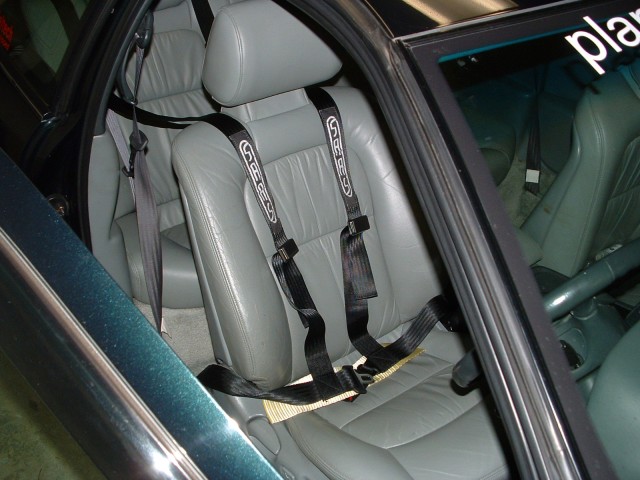
A two inch 4 point harness by SAAS. Stops sliding around the leather chairs - looks great - and does feel very nice to drive in. I got the removable type with the eye bolts. I did three trackdays before getting this item. $110 - $160.
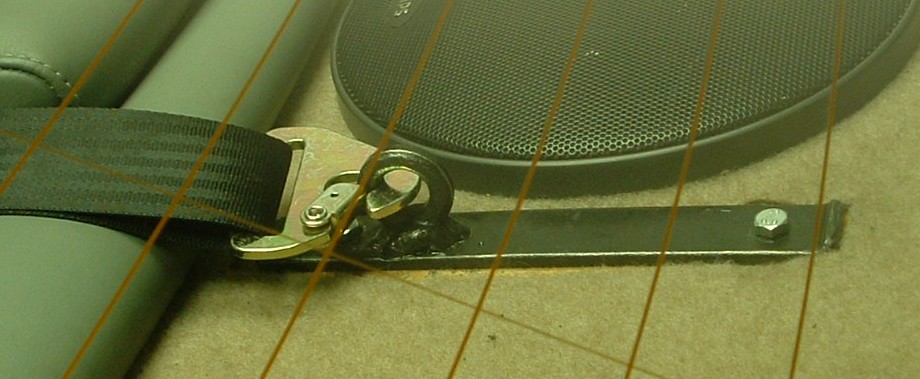
Couldn't decide how to mount it. So in the end I used a hacksaw to remove the eye bolts from the bolt threads provided and got the local exhaust shop to weld them to the standard seat belt bolts. The welding cost $10. I used a custom metal strap for the back parcel shelf - two bolt holes are already there in parcel shelf at the back. You'll have to remove the back seat and carpet to check them out.
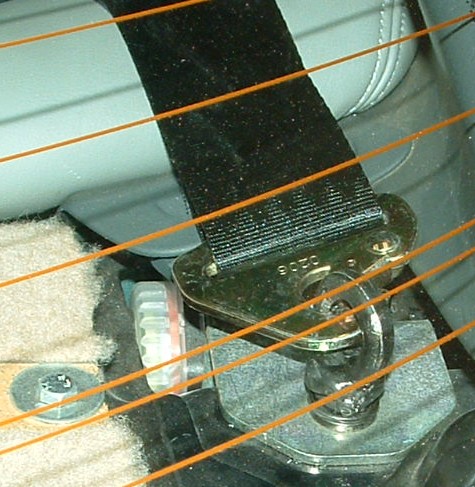
Welded the eyebolt to the back passenger seatbelt bolt. Rear straps should be as close to horizontal as possible. Mount rear straps to parcel shelf - not the floor. This is to stop spine compression in case of an accident.
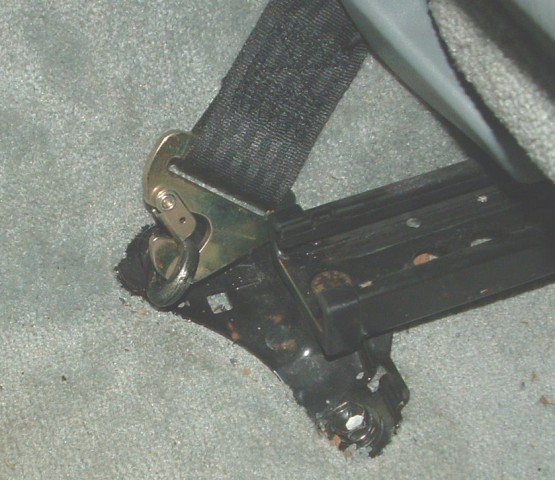
Bolt to transmission tunnel - welded eyebolt to it as well - bit tight to thread belt past seat but works ok.
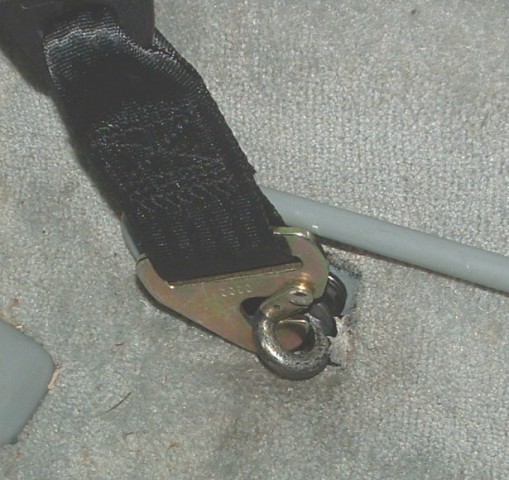
The bolt for the sliding belt rail - also welded up with an eyebolt on top of standard bolt. Harness unclips in seconds if you don't want to use it. You'll want to use it!
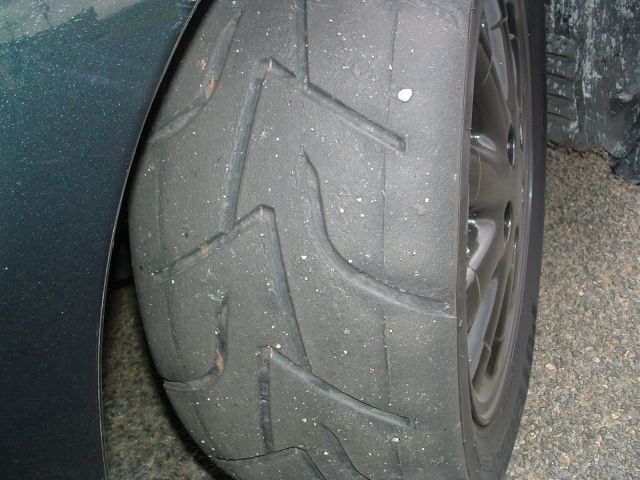
Tyres - I prefer the Bridgestone 540s road legal race tyre. Mounted on original 16 inch rim - I use the affordable 225/50/16 size - $255 to $350 each - big price variation - shop around. These 225 race tyres provide ample grip - they destroy my 265 street tyres for sheer grip etc. But very noisy on the road. I drive to Mallala with them on since they are street legal - hums and whirrs and pulls and tramlines all the way there - but grip to die for. So controllable. To Phillip Island I stick three in the boot and one on back seat and change them when I get there. Race tyres run lower pressures and have stiffer sidewalls. Aim for 36-38 psi hot. I get a 10 psi pressure rise when on track so I go for 28 psi cold. Street tyres aim for 38 psi cold.
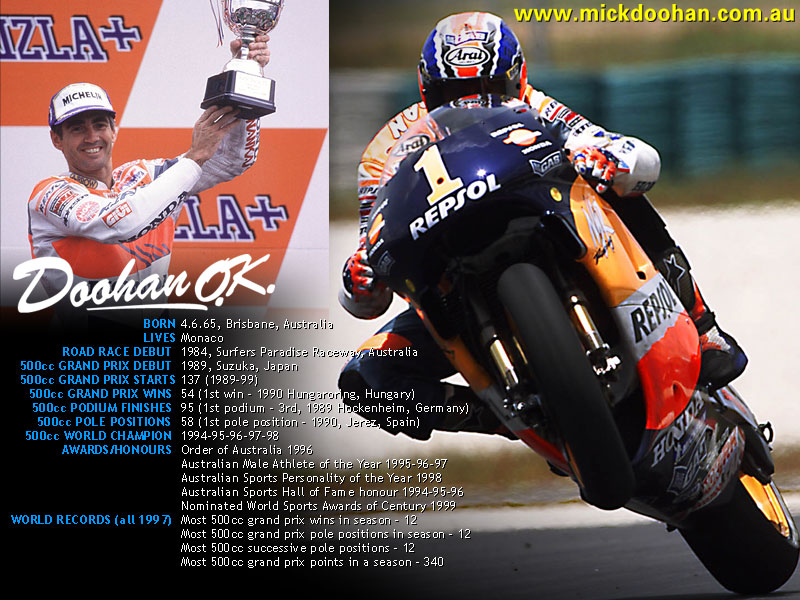
No more bikes for me - but I still have my Mick Doohan bleary eyeball helmet!